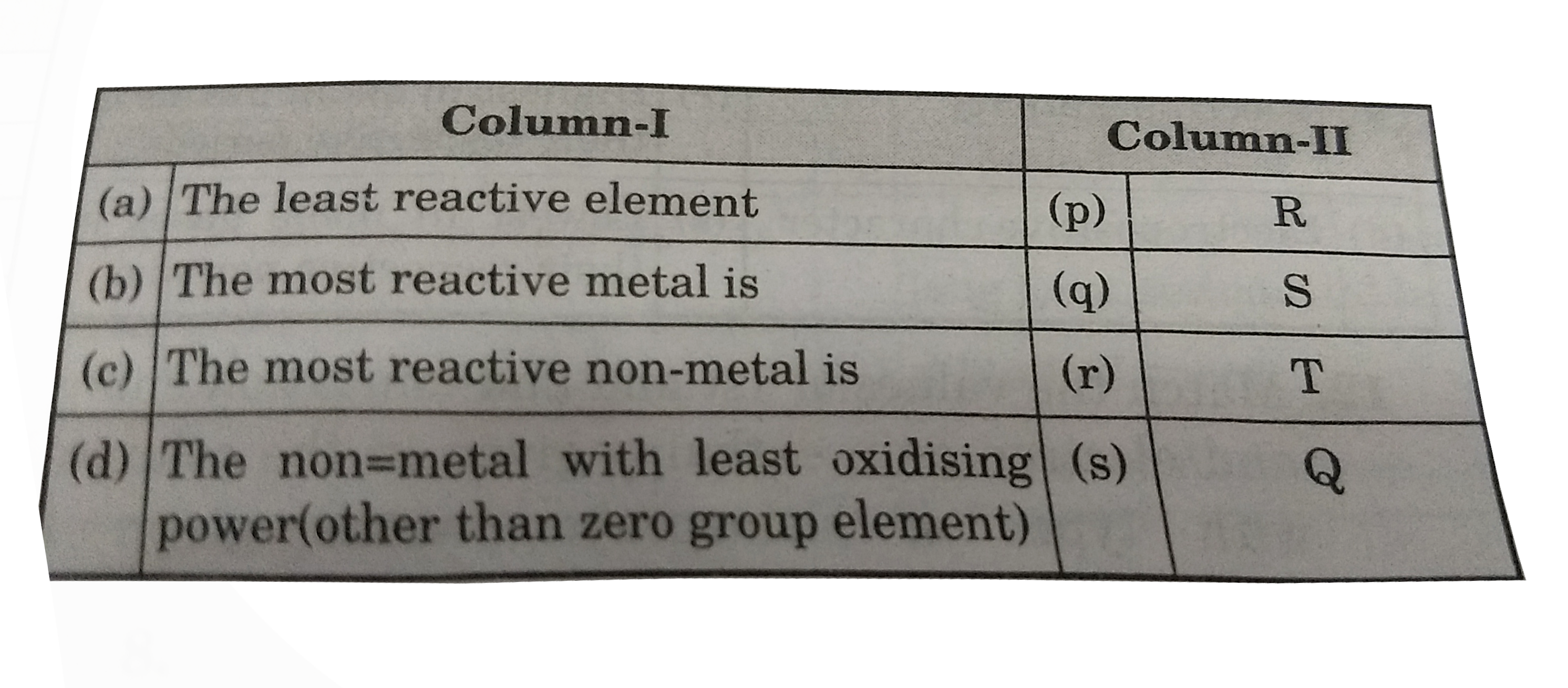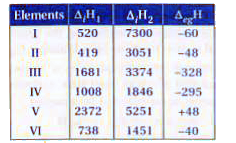The first IE and second IE (Kjmol−1) and da<aegH(kJmol−1) of a few elements are given below:
 Which of the above is likely to be the metal that can from stable binary halide(MX2)Solution in Malayalam
Which of the above is likely to be the metal that can from stable binary halide(MX2)Solution in Malayalam
Elements VI (low IE1maching with group 2 metals)
Topper's Solved these Questions
Similar Questions
Write the Lewis dot structure of CO molecule.
View SolutionDefine environmental chemistry.
View SolutionThe first four ionization enthalpies of an element are 578kJmol−1,1817kJmol−1,2745kJmol−1, and 11575kJmol−1. The element is
View SolutionThe first (ΔH1) and second (ΔH2) ionisation enthalpies (in kJmol−1) and the (ΔHeg) electron gain enthalpy (in kJmol−1) of a elements are given below:

Based on the above information match the following columns.

View SolutionAn element X has IE and EA respectively 275 and 1450 kJ mol−1. The electronegativity of element according to Pauling scale is
View SolutionThe first (ΔIH1) and second (ΔIH2) ionisation enthalpies (in kJ mol−1) and the (ΔegH) electron gain enthalpy (in kJ mol−1) of a few elements are given below:

The least reactive element is :
View SolutionWhich represents alkali metals (i.e. 1^(st) group metals) based on (IE)_(1) and (IE)_(2) value (in KJ//mol) ?
View SolutionFirst and second ionisation enthalpies(in KJ/mol) of few elements are given below: Which of the above elements will form halides with formula MX_(2) ?
View Solutionनिम्न की आयनिक अभिक्रियाओं को ध्यान रखते हुए
A(g)→A+(g)+e−→ IE (KJ/mol) में A1 है
A+(g)→A+2(g)+e−→ IE (KJ/mol) में A2 है
A+2(g)→A+3(g)+e−→ IE (KJ/mol) में A3 है
तब IE का सही क्रम होगा :-
View SolutionFirst and second ionisation enthalpies(in KJ/mol) of few elements are given below:

Which of the above elements will form halides with formula MX2?
View SolutionThe first (ΔiH1) and the second (ΔiH2) ionization enthalpies (in kJ mol−1) and the (ΔegH) electron gain enthalpy (in kJ mol −1) of a few elements are given below :

Which of the above elements is likely to be :
(a) the least reactive element.
(b) the most reactive metal.
(c) the most reactive non-metal.
(d) the least reactive non-metal.
(e) the metal which can form a stable binary halide of the formula MX2 , (X = halogen).
(f) the metal which can form a predominantly stable covalent halide of the formula MX (X = halogen)?
View SolutionThe first IE and second IE (Kj mol^(-1)) and dalta_egH(kJ mol^(-1)) of a few elements are given below: Which of the above is likely to be the least reactive element
View SolutionThe first IE and second IE (Kj mol^(-1)) and dalta_egH(kJ mol^(-1)) of a few elements are given below: Which of the above is likely to be the least reactive non-metal
View SolutionThe first IE and second IE (Kj mol^(-1)) and dalta_egH(kJ mol^(-1)) of a few elements are given below: Which of the above is likely to be the metal that can from perdominantly stable covalent halide (MX) ?
View SolutionThe first (IE1) and the second (IE2) ionisation energies (kJ mol−1) of a few elements are given below :

Which of the above elements is likely to be
a reactive metal?
View Solution
